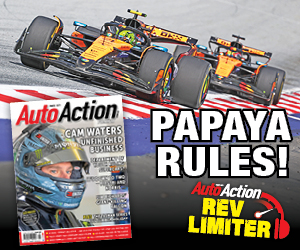Sainz headlines tight final practice in Bahrain
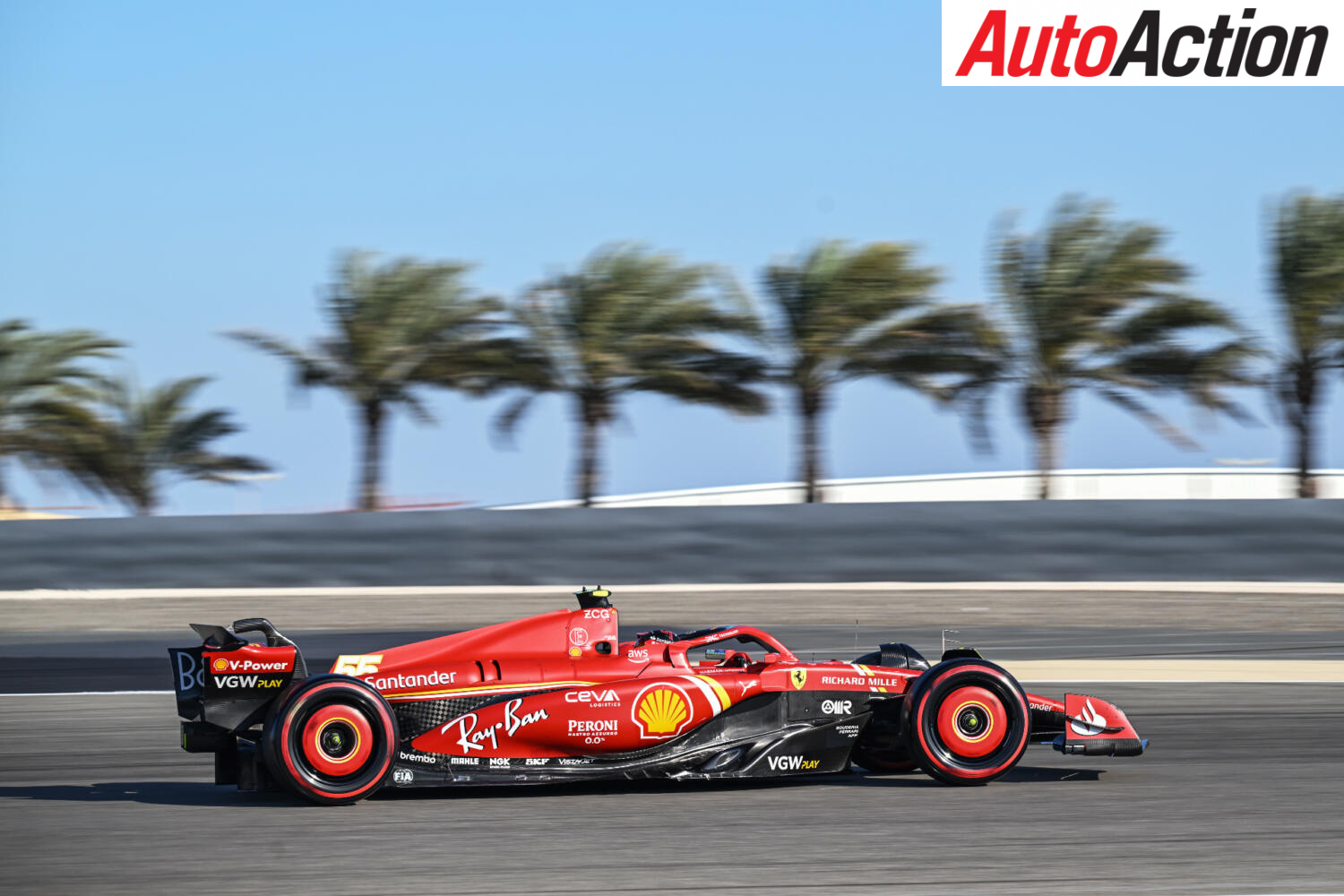
By Reese Mautone
Date posted: 2 March 2024
Ahead of the first highly anticipated qualifying session of the year, FP3 highlighted the closeness of the grid, with the entire field, headed by Carlos Sainz, separated by just one and a half seconds.
It was a quiet start to FP3 at the Bahrain International Circuit, with all 20 drivers remaining in their respective garages for the opening moments of the session.
Yesterday’s fastest man, Lewis Hamilton, was the first to venture out on track for a single flying lap before retreating.
He set an opening benchmark of 1:32.733s on the soft compound tyre, showering sparks as his W15 travelled through Turn 12.
Shortly after, Ferrari took the plunge with Carlos Sainz leading Charles Leclerc out of the pitlane.
The Spaniard’s opening sector was two-tenths slower than his 2025 replacement’s, and despite making up ground in Sectors 2 and 3, he fell just shy.
Leclerc jumped to the top of the pecking order, coinciding with mass movement in the pitlane as the majority of the grid filed out.
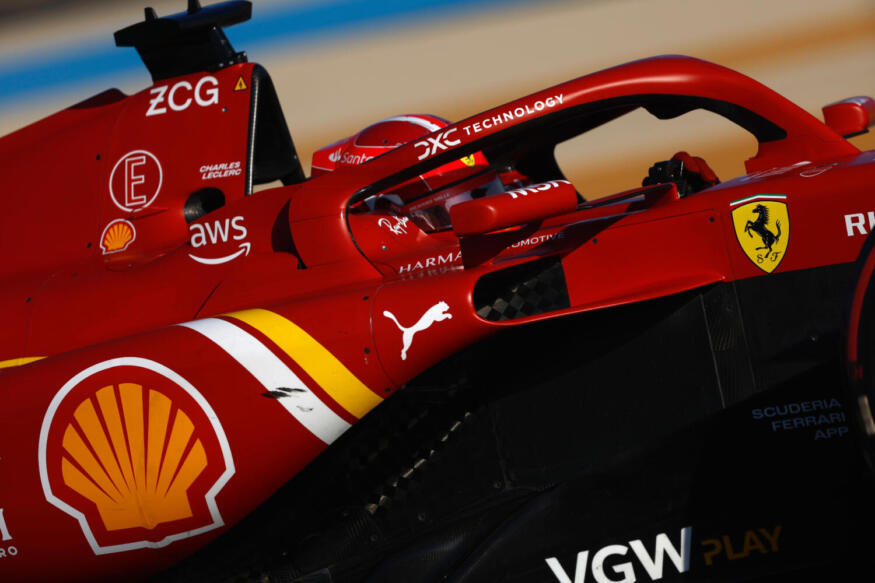
Charles Leclerc, Ferrari SF-24, during FP3 at the Bahrain GP. Image: Zak Mauger / LAT Images.
With 40 minutes remaining in the session, the timing sheets began to fill up.
Sergio Perez jumped on the blower to his team to report of “nasty” upshifts in his RB20, an issue Max Verstappen struggled with during yesterday’s running.
Throughout the remainder of the session, the Mexican’s complaints continued, with Perez describing the upshifts as “really bad”.
One pair of ears the complaints weren’t falling on was Christian Horner’s, with the Red Bull Team Principal momentarily absent from the pit wall.
Horner was busy in a meeting with F1 CEO, Stefano Domenicali and FIA President, Mohammed Ben Sulayem regarding the infamous leaked messages shared yesterday.
Meanwhile, all drivers had opted to start their running on the soft tyre, bar the Red Bull duo.
Despite running the slower tyres, Verstappen sat ahead of Oscar Piastri, with the Australian’s MCL38 coughing up smoke at the halfway point of FP3.
He returned to his McLaren garage, joining his teammate whose car was undergoing a setup change.
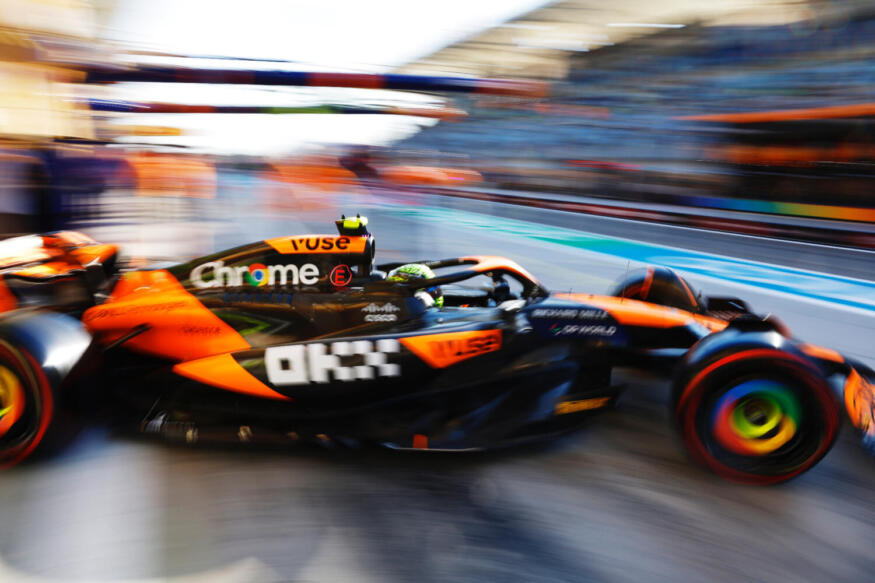
Lando Norris, McLaren MCL38, leaving his garage during the final practice session in Bahrain. Image: Steven Tee / LAT Images.
George Russell found himself sitting over half a second clear of P2, before being demoted by a flying Fernando Alonso.
The veteran went purple in the first and middle sectors of the lap, setting the fastest time of a 1:31.582s.
Despite one Mercedes sitting with the second quickest time, Hamilton was back on the fringes of the top ten, still a significant 1.1 seconds off the pace with replays showing him locking up and running wide.
Yuki Tsunoda split the Ferrari drivers as he slotted into P4, his VCARB01 continuing to display positive signs ahead of the later Qualifying session.
There were worrying signs for Alpine, however, as Pierre Gasly failed to improve from P17.
His teammate wasn’t doing much better either in P12, with Esteban Ocon still a decent 1.4 seconds behind Alonso.
As a lull fell over the Bahrain International Circuit, the Red Bulls were one of a few cars that remained on track, both making the switch to the C3 tyre.
Perez immediately jumped to the top of the order, however, his time of 1:31.248 was instantly smashed by his reigning world championship-winning teammate.
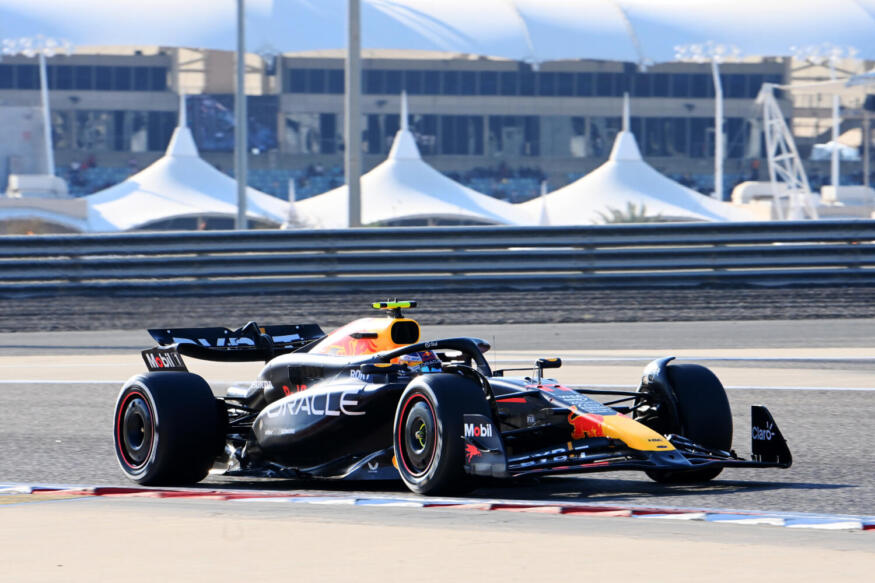
Sergio Perez, Red Bull Racing RB20, during FP3 at the Bahrain GP. Image: Mark Sutton / Sutton Images.
They weren’t clear of threat, with the grid rejoining the session with purpose for their Quali simulations.
It was a matter of milliseconds that saw Alonso reclaiming the top spot, with the Spaniard saying that he felt “connected with the car”.
The McLarens, although not quick enough for P1, improved from the back end of the grid to the third and fourth-fastest times, notably splitting the Bulls.
Soon it was time for the younger of the two Spaniards to shine, with Sainz beating Alonso’s middle sector and ultimately his total lap time to go P1 with a 1:30.824s.
Leclerc set personal bests across the lap, however, it wasn’t quite clean enough to breach the top three, sitting 0.270 seconds back on his teammate.
The Monegasque ultimately put the messy lap down to the viability issues, with the lowering sun acting as a hindrance in the closing stages.
Another driver not having the cleanest of runs in FP3 was Pierre Gasly who had a twitchy moment at Turn 4, losing rear grip as he rode the kerb.
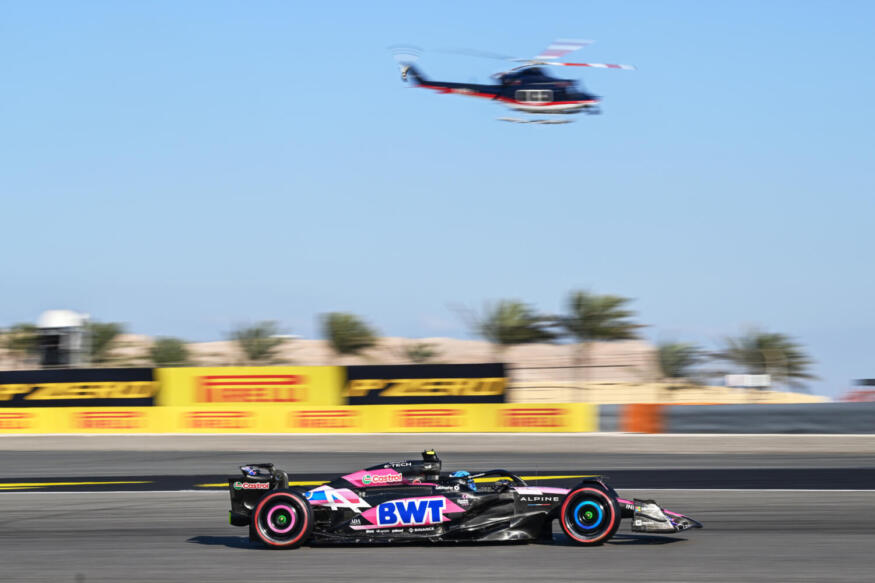
Pierre Gasly, Alpine A524, during the final practice at the Bahrain GP. Image: Simon Galloway / LAT Images.
With just minutes on the clock, Ocon and Gasly held the two slowest times of the session, with the #31 only improving to P18 on his final run.
As the chequered flag fell on FP3, 14 drivers were incredibly separated by just eight-tenths, setting the scene for an incredibly close qualifying session in just a few hours.
Carlos Sainz took the coveted P1 slot, 0.141 seconds ahead of his compatriot in P2.
Meanwhile, Max Verstappen finished in P3, a slim 32 milliseconds ahead of the second-running Ferrari of Charles Leclerc.
As for our Australians, Daniel Ricciardo had dropped out of the top ten to be sitting with the eleventh fastest time, while Piastri had been slightly more successful in P7.
The highly anticipated first Qualifying session of the 2024 season will start at 3:00 AM, AEST, under the floodlights in Bahrain.
FP3 Results:
| POS |
NO |
DRIVER |
CAR |
TIME |
GAP |
LAPS |
| 1 |
55 |
Carlos Sainz |
FERRARI |
1:30.824 |
|
18 |
| 2 |
14 |
Fernando Alonso |
ASTON MARTIN ARAMCO MERCEDES |
1:30.965 |
+0.141s |
18 |
| 3 |
1 |
Max Verstappen |
RED BULL RACING HONDA RBPT |
1:31.062 |
+0.238s |
16 |
| 4 |
16 |
Charles Leclerc |
FERRARI |
1:31.094 |
+0.270s |
17 |
| 5 |
4 |
Lando Norris |
MCLAREN MERCEDES |
1:31.118 |
+0.294s |
12 |
| 6 |
63 |
George Russell |
MERCEDES |
1:31.190 |
+0.366s |
12 |
| 7 |
81 |
Oscar Piastri |
MCLAREN MERCEDES |
1:31.210 |
+0.386s |
13 |
| 8 |
11 |
Sergio Perez |
RED BULL RACING HONDA RBPT |
1:31.248 |
+0.424s |
17 |
| 9 |
27 |
Nico Hulkenberg |
HAAS FERRARI |
1:31.278 |
+0.454s |
13 |
| 10 |
18 |
Lance Stroll |
ASTON MARTIN ARAMCO MERCEDES |
1:31.396 |
+0.572s |
17 |
| 11 |
3 |
Daniel Ricciardo |
RB HONDA RBPT |
1:31.449 |
+0.625s |
13 |
| 12 |
44 |
Lewis Hamilton |
MERCEDES |
1:31.452 |
+0.628s |
20 |
| 13 |
22 |
Yuki Tsunoda |
RB HONDA RBPT |
1:31.631 |
+0.807s |
14 |
| 14 |
20 |
Kevin Magnussen |
HAAS FERRARI |
1:31.671 |
+0.847s |
20 |
| 15 |
23 |
Alexander Albon |
WILLIAMS MERCEDES |
1:31.965 |
+1.141s |
17 |
| 16 |
24 |
Zhou Guanyu |
KICK SAUBER FERRARI |
1:32.000 |
+1.176s |
17 |
| 17 |
77 |
Valtteri Bottas |
KICK SAUBER FERRARI |
1:32.096 |
+1.272s |
16 |
| 18 |
31 |
Esteban Ocon |
ALPINE RENAULT |
1:32.124 |
+1.300s |
11 |
| 19 |
2 |
Logan Sargeant |
WILLIAMS MERCEDES |
1:32.125 |
+1.301s |
16 |
| 20 |
10 |
Pierre Gasly |
ALPINE RENAULT |
1:32.382 |
+1.558s |
14 |
There is also lots more loaded into a bumper edition of AUTO ACTION magazine, on sale at newsagents and available digitally here. For more of the latest motorsport news, subscribe to AUTO ACTION magazine.
Latest Podcast: Bathurst 500 review on the Auto Action RevLimiter!
Bruce is back this week after sitting on the bench with illness and a lack of fuel, and he joins Andrew and PG on the Auto Action Rev Limiter as they look at the latest in motorsport.
Listen to our latest episode on your podcast app of choice or here.



Recent Stories
array (
0 =>
WP_Term::__set_state(array(
'term_id' => 37,
'name' => 'F1',
'slug' => 'f1',
'term_group' => 0,
'term_taxonomy_id' => 37,
'taxonomy' => 'category',
'description' => 'An Introduction to Formula One (F1)
Formula One, or F1, is the highest class of single-seater auto racing, governed by the Fédération Internationale de l\'Automobile (FIA) and is owned by Liberty Media. The name "Formula One" refers to the set of rules or formula that all cars and drivers must comply with.
The F1 season consists of a series of races, known as Grands Prix, held on purpose-built circuits or public roads around the world. The results of each race are combined to determine two annual championships: one for drivers and one for constructors (teams).
The history of Formula One can be traced back to the pre-war Grand Prix racing, which featured open-wheel cars with supercharged engines. The first World Championship of Drivers was organised by the FIA in 1950, following the end of World War II. The first race was held at Silverstone, England, and was won by Giuseppe Farina, driving an Alfa Romeo. The first constructors\' championship was introduced in 1958 and was won by Vanwall.
Formula One has seen many changes and innovations over the years, both in terms of technology and regulations. Some of the most notable developments include the introduction of rear-engined cars in the late 1950s, the use of aerodynamic wings in the late 1960s, the adoption of turbocharged engines in the late 1970s, the emergence of electronic driver aids in the late 1980s, the switch to V10 and then V8 engines in the 1990s and 2000s, and the introduction of hybrid power units in 2014.
Formula One has also produced some of the greatest drivers and rivalries in the history of motorsport. Some of the most famous names include Juan Manuel Fangio, Jim Clark, Jackie Stewart, Niki Lauda, Ayrton Senna, Alain Prost, Michael Schumacher, Lewis Hamilton, and Sebastian Vettel. Some of the most intense battles for the championship have been between Fangio and Stirling Moss in the 1950s, Lauda and James Hunt in the 1970s, Senna and Prost in the late 1980s, Schumacher and Mika Hakkinen in the late 1990s, and Hamilton and Vettel in the 2010s.
Formula One is widely regarded as the pinnacle of motorsport, attracting millions of fans and viewers worldwide. The sport is also a huge business, involving billions of dollars in revenue and expenditure. The teams compete for prize money, sponsorship deals, and media rights, while the drivers earn millions of dollars in salaries and endorsements. The sport is also influenced by politics, regulations, and controversies, such as doping scandals, espionage cases, safety issues, and environmental concerns.
The following is a list of all F1 World Drivers Champions by year, from 1950 to 2020:
1950-1959
1950: Giuseppe Farina (Italy) - Alfa Romeo 158, Alfa Romeo
1951: Juan Manuel Fangio (Argentina) - Alfa Romeo 159, Alfa Romeo
1952: Alberto Ascari (Italy) - Ferrari 500, Ferrari
1953: Alberto Ascari (Italy) - Ferrari 500, Ferrari
1954: Juan Manuel Fangio (Argentina) - Maserati 250F, Maserati / Mercedes-Benz W196, Mercedes-Benz
1955: Juan Manuel Fangio (Argentina) - Mercedes-Benz W196, Mercedes-Benz
1956: Juan Manuel Fangio (Argentina) - Ferrari D50, Ferrari
1957: Juan Manuel Fangio (Argentina) - Maserati 250F, Maserati
1958: Mike Hawthorn (United Kingdom) - Ferrari 246, Ferrari
1959: Jack Brabham (Australia) - Cooper T51, Cooper-Climax
1960-1969
1960: Jack Brabham (Australia) - Cooper T53, Cooper-Climax
1961: Phil Hill (United States) - Ferrari 156, Ferrari
1962: Graham Hill (United Kingdom) - BRM P57, BRM
1963: Jim Clark (United Kingdom) - Lotus 25, Lotus-Climax
1964: John Surtees (United Kingdom) - Ferrari 158, Ferrari
1965: Jim Clark (United Kingdom) - Lotus 33, Lotus-Climax
1966: Jack Brabham (Australia) - Brabham BT19, Brabham-Repco
1967: Denny Hulme (New Zealand) - Brabham BT20, Brabham-Repco
1968: Graham Hill (United Kingdom) - Lotus 49, Lotus-Ford
1969: Jackie Stewart (United Kingdom) - Matra MS80, Matra-Ford
1970-1979
1970: Jochen Rindt (Austria) - Lotus 72, Lotus-Ford
1971: Jackie Stewart (United Kingdom) - Tyrrell 003, Tyrrell-Ford
1972: Emerson Fittipaldi (Brazil) - Lotus 72D, Lotus-Ford
1973: Jackie Stewart (United Kingdom) - Tyrrell 006, Tyrrell-Ford
1974: Emerson Fittipaldi (Brazil) - McLaren M23, McLaren-Ford
1975: Niki Lauda (Austria) - Ferrari 312T, Ferrari
1976: James Hunt (United Kingdom) - McLaren M23, McLaren-Ford
1977: Niki Lauda (Austria) - Ferrari 312T2, Ferrari
1978: Mario Andretti (United States) - Lotus 79, Lotus-Ford
1979: Jody Scheckter (South Africa) - Ferrari 312T4, Ferrari
1980-1989
1980: Alan Jones (Australia) - Williams FW07B, Williams-Ford
1981: Nelson Piquet (Brazil) - Brabham BT49C, Brabham-Ford
1982: Keke Rosberg (Finland) - Williams FW08, Williams-Ford
1983: Nelson Piquet (Brazil) - Brabham BT52, Brabham-BMW
1984: Niki Lauda (Austria) - McLaren MP4/2, McLaren-TAG
1985: Alain Prost (France) - McLaren MP4/2B, McLaren-TAG
1986: Alain Prost (France) - McLaren MP4/2C, McLaren-TAG
1987: Nelson Piquet (Brazil) - Williams FW11B, Williams-Honda
1988: Ayrton Senna (Brazil) - McLaren MP4/4, McLaren-Honda
1989: Alain Prost (France) - McLaren MP4/5, McLaren-Honda
1990-1999
1990: Ayrton Senna (Brazil) - McLaren MP4/5B, McLaren-Honda
1991: Ayrton Senna (Brazil) - McLaren MP4/6, McLaren-Honda
1992: Nigel Mansell (United Kingdom) - Williams FW14B, Williams-Renault
1993: Alain Prost (France) - Williams FW15C, Williams-Renault
1994: Michael Schumacher (Germany) - Benetton B194, Benetton-Ford
1995: Michael Schumacher (Germany) - Benetton B195, Benetton-Renault
1996: Damon Hill (United Kingdom) - Williams FW18, Williams-Renault
1997: Jacques Villeneuve (Canada) - Williams FW19, Williams-Renault
1998: Mika Häkkinen (Finland) - McLaren MP4/13, McLaren-Mercedes
1999: Mika Häkkinen (Finland) - McLaren MP4/14, McLaren-Mercedes
2000-2009
2000: Michael Schumacher (Germany) - Ferrari F1-2000, Ferrari
2001: Michael Schumacher (Germany) - Ferrari F2001, Ferrari
2002: Michael Schumacher (Germany) - Ferrari F2002, Ferrari
2003: Michael Schumacher (Germany) - Ferrari F2003-GA, Ferrari
2004: Michael Schumacher (Germany) - Ferrari F2004, Ferrari
2005: Fernando Alonso (Spain) - Renault R25, Renault
2006: Fernando Alonso (Spain) - Renault R26, Renault
2007: Kimi Räikkönen (Finland) - Ferrari F2007, Ferrari
2008: Lewis Hamilton (United Kingdom) - McLaren MP4-23, McLaren-Mercedes
2009: Jenson Button (United Kingdom) - Brawn BGP 001, Brawn-Mercedes
2010-2020
2010: Sebastian Vettel (Germany) - Red Bull RB6, Red Bull-Renault
2011: Sebastian Vettel (Germany) - Red Bull RB7, Red Bull-Renault
2012: Sebastian Vettel (Germany) - Red Bull RB8, Red Bull-Renault
2013: Sebastian Vettel (Germany) - Red Bull RB9, Red Bull-Renault
2014: Lewis Hamilton (United Kingdom) - Mercedes F1 W05 Hybrid, Mercedes
2015: Lewis Hamilton (United Kingdom) - Mercedes F1 W06 Hybrid, Mercedes
2016: Nico Rosberg (Germany) - Mercedes F1 W07 Hybrid, Mercedes
2017: Lewis Hamilton (United Kingdom) - Mercedes F1 W08 EQ Power+, Mercedes
2018: Lewis Hamilton (United Kingdom) - Mercedes F1 W09 EQ Power+, Mercedes
2019: Lewis Hamilton (United Kingdom) - Mercedes F1 W10 EQ Power+, Mercedes
2020: Lewis Hamilton (United Kingdom) - Mercedes F1 W11 EQ Power+, Mercedes
2021-
2021: Max Verstappen (Netherlands) – Red Bull RB16B, Honda
2022: Max Verstappen (Netherlands) – Red Bull RB18, Red Bull Power Trains Honda
2023: Max Verstappen (Netherlands) – Red Bull RB19, Red Bull Power Trains Honda
2024: Max Verstappen (Netherlands) – Red Bull RB20, Red Bull Power Trains Honda',
'parent' => 660,
'count' => 2879,
'filter' => 'raw',
'cat_ID' => 37,
'category_count' => 2879,
'category_description' => 'An Introduction to Formula One (F1)
Formula One, or F1, is the highest class of single-seater auto racing, governed by the Fédération Internationale de l\'Automobile (FIA) and is owned by Liberty Media. The name "Formula One" refers to the set of rules or formula that all cars and drivers must comply with.
The F1 season consists of a series of races, known as Grands Prix, held on purpose-built circuits or public roads around the world. The results of each race are combined to determine two annual championships: one for drivers and one for constructors (teams).
The history of Formula One can be traced back to the pre-war Grand Prix racing, which featured open-wheel cars with supercharged engines. The first World Championship of Drivers was organised by the FIA in 1950, following the end of World War II. The first race was held at Silverstone, England, and was won by Giuseppe Farina, driving an Alfa Romeo. The first constructors\' championship was introduced in 1958 and was won by Vanwall.
Formula One has seen many changes and innovations over the years, both in terms of technology and regulations. Some of the most notable developments include the introduction of rear-engined cars in the late 1950s, the use of aerodynamic wings in the late 1960s, the adoption of turbocharged engines in the late 1970s, the emergence of electronic driver aids in the late 1980s, the switch to V10 and then V8 engines in the 1990s and 2000s, and the introduction of hybrid power units in 2014.
Formula One has also produced some of the greatest drivers and rivalries in the history of motorsport. Some of the most famous names include Juan Manuel Fangio, Jim Clark, Jackie Stewart, Niki Lauda, Ayrton Senna, Alain Prost, Michael Schumacher, Lewis Hamilton, and Sebastian Vettel. Some of the most intense battles for the championship have been between Fangio and Stirling Moss in the 1950s, Lauda and James Hunt in the 1970s, Senna and Prost in the late 1980s, Schumacher and Mika Hakkinen in the late 1990s, and Hamilton and Vettel in the 2010s.
Formula One is widely regarded as the pinnacle of motorsport, attracting millions of fans and viewers worldwide. The sport is also a huge business, involving billions of dollars in revenue and expenditure. The teams compete for prize money, sponsorship deals, and media rights, while the drivers earn millions of dollars in salaries and endorsements. The sport is also influenced by politics, regulations, and controversies, such as doping scandals, espionage cases, safety issues, and environmental concerns.
The following is a list of all F1 World Drivers Champions by year, from 1950 to 2020:
1950-1959
1950: Giuseppe Farina (Italy) - Alfa Romeo 158, Alfa Romeo
1951: Juan Manuel Fangio (Argentina) - Alfa Romeo 159, Alfa Romeo
1952: Alberto Ascari (Italy) - Ferrari 500, Ferrari
1953: Alberto Ascari (Italy) - Ferrari 500, Ferrari
1954: Juan Manuel Fangio (Argentina) - Maserati 250F, Maserati / Mercedes-Benz W196, Mercedes-Benz
1955: Juan Manuel Fangio (Argentina) - Mercedes-Benz W196, Mercedes-Benz
1956: Juan Manuel Fangio (Argentina) - Ferrari D50, Ferrari
1957: Juan Manuel Fangio (Argentina) - Maserati 250F, Maserati
1958: Mike Hawthorn (United Kingdom) - Ferrari 246, Ferrari
1959: Jack Brabham (Australia) - Cooper T51, Cooper-Climax
1960-1969
1960: Jack Brabham (Australia) - Cooper T53, Cooper-Climax
1961: Phil Hill (United States) - Ferrari 156, Ferrari
1962: Graham Hill (United Kingdom) - BRM P57, BRM
1963: Jim Clark (United Kingdom) - Lotus 25, Lotus-Climax
1964: John Surtees (United Kingdom) - Ferrari 158, Ferrari
1965: Jim Clark (United Kingdom) - Lotus 33, Lotus-Climax
1966: Jack Brabham (Australia) - Brabham BT19, Brabham-Repco
1967: Denny Hulme (New Zealand) - Brabham BT20, Brabham-Repco
1968: Graham Hill (United Kingdom) - Lotus 49, Lotus-Ford
1969: Jackie Stewart (United Kingdom) - Matra MS80, Matra-Ford
1970-1979
1970: Jochen Rindt (Austria) - Lotus 72, Lotus-Ford
1971: Jackie Stewart (United Kingdom) - Tyrrell 003, Tyrrell-Ford
1972: Emerson Fittipaldi (Brazil) - Lotus 72D, Lotus-Ford
1973: Jackie Stewart (United Kingdom) - Tyrrell 006, Tyrrell-Ford
1974: Emerson Fittipaldi (Brazil) - McLaren M23, McLaren-Ford
1975: Niki Lauda (Austria) - Ferrari 312T, Ferrari
1976: James Hunt (United Kingdom) - McLaren M23, McLaren-Ford
1977: Niki Lauda (Austria) - Ferrari 312T2, Ferrari
1978: Mario Andretti (United States) - Lotus 79, Lotus-Ford
1979: Jody Scheckter (South Africa) - Ferrari 312T4, Ferrari
1980-1989
1980: Alan Jones (Australia) - Williams FW07B, Williams-Ford
1981: Nelson Piquet (Brazil) - Brabham BT49C, Brabham-Ford
1982: Keke Rosberg (Finland) - Williams FW08, Williams-Ford
1983: Nelson Piquet (Brazil) - Brabham BT52, Brabham-BMW
1984: Niki Lauda (Austria) - McLaren MP4/2, McLaren-TAG
1985: Alain Prost (France) - McLaren MP4/2B, McLaren-TAG
1986: Alain Prost (France) - McLaren MP4/2C, McLaren-TAG
1987: Nelson Piquet (Brazil) - Williams FW11B, Williams-Honda
1988: Ayrton Senna (Brazil) - McLaren MP4/4, McLaren-Honda
1989: Alain Prost (France) - McLaren MP4/5, McLaren-Honda
1990-1999
1990: Ayrton Senna (Brazil) - McLaren MP4/5B, McLaren-Honda
1991: Ayrton Senna (Brazil) - McLaren MP4/6, McLaren-Honda
1992: Nigel Mansell (United Kingdom) - Williams FW14B, Williams-Renault
1993: Alain Prost (France) - Williams FW15C, Williams-Renault
1994: Michael Schumacher (Germany) - Benetton B194, Benetton-Ford
1995: Michael Schumacher (Germany) - Benetton B195, Benetton-Renault
1996: Damon Hill (United Kingdom) - Williams FW18, Williams-Renault
1997: Jacques Villeneuve (Canada) - Williams FW19, Williams-Renault
1998: Mika Häkkinen (Finland) - McLaren MP4/13, McLaren-Mercedes
1999: Mika Häkkinen (Finland) - McLaren MP4/14, McLaren-Mercedes
2000-2009
2000: Michael Schumacher (Germany) - Ferrari F1-2000, Ferrari
2001: Michael Schumacher (Germany) - Ferrari F2001, Ferrari
2002: Michael Schumacher (Germany) - Ferrari F2002, Ferrari
2003: Michael Schumacher (Germany) - Ferrari F2003-GA, Ferrari
2004: Michael Schumacher (Germany) - Ferrari F2004, Ferrari
2005: Fernando Alonso (Spain) - Renault R25, Renault
2006: Fernando Alonso (Spain) - Renault R26, Renault
2007: Kimi Räikkönen (Finland) - Ferrari F2007, Ferrari
2008: Lewis Hamilton (United Kingdom) - McLaren MP4-23, McLaren-Mercedes
2009: Jenson Button (United Kingdom) - Brawn BGP 001, Brawn-Mercedes
2010-2020
2010: Sebastian Vettel (Germany) - Red Bull RB6, Red Bull-Renault
2011: Sebastian Vettel (Germany) - Red Bull RB7, Red Bull-Renault
2012: Sebastian Vettel (Germany) - Red Bull RB8, Red Bull-Renault
2013: Sebastian Vettel (Germany) - Red Bull RB9, Red Bull-Renault
2014: Lewis Hamilton (United Kingdom) - Mercedes F1 W05 Hybrid, Mercedes
2015: Lewis Hamilton (United Kingdom) - Mercedes F1 W06 Hybrid, Mercedes
2016: Nico Rosberg (Germany) - Mercedes F1 W07 Hybrid, Mercedes
2017: Lewis Hamilton (United Kingdom) - Mercedes F1 W08 EQ Power+, Mercedes
2018: Lewis Hamilton (United Kingdom) - Mercedes F1 W09 EQ Power+, Mercedes
2019: Lewis Hamilton (United Kingdom) - Mercedes F1 W10 EQ Power+, Mercedes
2020: Lewis Hamilton (United Kingdom) - Mercedes F1 W11 EQ Power+, Mercedes
2021-
2021: Max Verstappen (Netherlands) – Red Bull RB16B, Honda
2022: Max Verstappen (Netherlands) – Red Bull RB18, Red Bull Power Trains Honda
2023: Max Verstappen (Netherlands) – Red Bull RB19, Red Bull Power Trains Honda
2024: Max Verstappen (Netherlands) – Red Bull RB20, Red Bull Power Trains Honda',
'cat_name' => 'F1',
'category_nicename' => 'f1',
'category_parent' => 660,
)),
1 =>
WP_Term::__set_state(array(
'term_id' => 660,
'name' => 'International',
'slug' => 'international',
'term_group' => 0,
'term_taxonomy_id' => 660,
'taxonomy' => 'category',
'description' => '',
'parent' => 0,
'count' => 2874,
'filter' => 'raw',
'cat_ID' => 660,
'category_count' => 2874,
'category_description' => '',
'cat_name' => 'International',
'category_nicename' => 'international',
'category_parent' => 0,
)),
2 =>
WP_Term::__set_state(array(
'term_id' => 11,
'name' => 'Latest News',
'slug' => 'latest-news',
'term_group' => 0,
'term_taxonomy_id' => 11,
'taxonomy' => 'category',
'description' => '',
'parent' => 0,
'count' => 16700,
'filter' => 'raw',
'cat_ID' => 11,
'category_count' => 16700,
'category_description' => '',
'cat_name' => 'Latest News',
'category_nicename' => 'latest-news',
'category_parent' => 0,
)),
)






